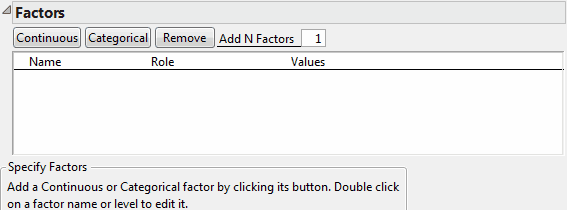Factors
Add factors in the Factors outline.
Figure 7.18 Factors Outline
The factors outline contains the following buttons.
Continuous
Enters the number of continuous factors specified in Add N Factors.
Categorical
Enters the number of nominal factors specified in Add N Factors.
Remove
Removes the selected factors.
Add N Factors
Adds multiple factors of a given type. Enter the number of factors to add and click Continuous or Categorical. Repeat Add N Factors to add multiple factors of different types.
Tip: When you have completed your Factors panel, select Save Factors from the red triangle menu. This saves the factor names and values in a data table that you can later reload. See Definitive Screening Design Options.
The Factors outline contains the following columns:
Name
The name of the factor. When added, a factor is given a default name of X1, X2, and so on. To change this name, double-click it and enter the desired name.
Role
Specifies the Design Role of the factor. The Design Role column property for the factor is saved to the data table. This property ensures that the factor type is modeled appropriately.
Values
The experimental settings for the factors. To insert Values, click the default values and type the desired values.
Editing the Factors Outline
In the Factors outline, note the following:
• To edit a factor name, double-click the factor name.
• To edit a value, click the value in the Values column.
Factor Types
Continuous
Numeric data types only. A continuous factor is a factor that you can conceptually set to any value between the lower and upper limits you supply, given the limitations of your measurement system.
Categorical
Either numeric or character data types with two levels. For a categorical factor, the value ordering is the order of the values, as entered from left to right. This ordering is saved in the Value Order column property after the design data table is created.
Factor Column Properties
For each factor, various column properties are saved to the data table.
Design Role
Each factor is assigned the Design Role column property. The Role that you specify in defining the factor determines the value of its Design Role column property. When you add a block under Design Options, that factor is assigned the Blocking value. The Design Role property reflects how the factor is intended to be used in modeling the experimental data. Design Role values are used in the Augment Design platform.
Factor Changes
Each factor is assigned the Factor Changes column property with a setting of Easy. In definitive screening designs, it is assumed that factor levels can be changed for each experimental run. Factor Changes values are used in the Evaluate Design and Augment Design platforms.
Coding
If the Design Role is Continuous, the Coding column property for the factor is saved. This property transforms the factor values so that the low and high values correspond to –1 and +1, respectively. The estimates and tests in the Fit Least Squares report are based on the transformed values.
Value Order
If the Design Role is Categorical or Blocking, the Value Order column property for the factor is saved. This property determines the order in which levels of the factor appear.
RunsPerBlock
Indicates the number of runs in each block. When a Block is selected in the Design Options outline and you then click Make Design, a factor with the default name Block is added to the Factors list. The RunsPerBlock column property is saved for that factor.
